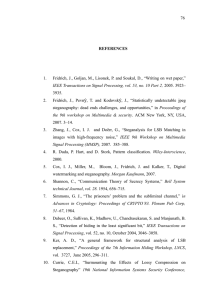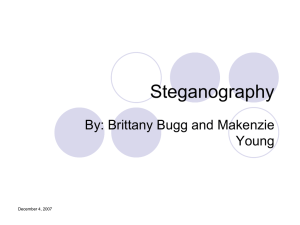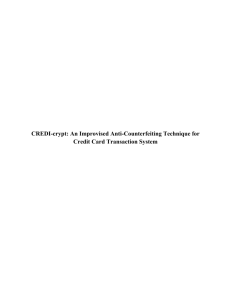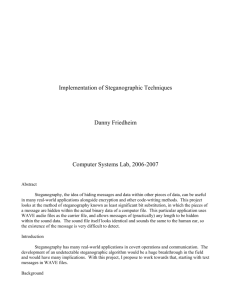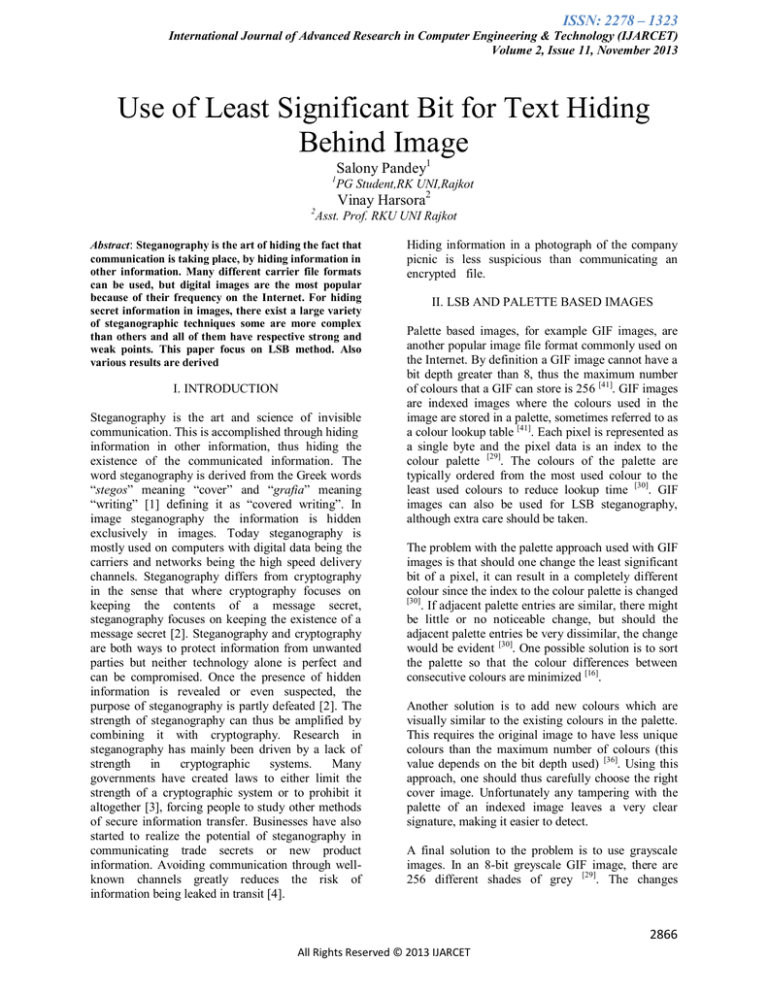
ISSN: 2278 – 1323
International Journal of Advanced Research in Computer Engineering & Technology (IJARCET)
Volume 2, Issue 11, November 2013
Use of Least Significant Bit for Text Hiding
Behind Image
Salony Pandey1
1
PG Student,RK UNI,Rajkot
Vinay Harsora2
2
Asst. Prof. RKU UNI Rajkot
Abstract: Steganography is the art of hiding the fact that
communication is taking place, by hiding information in
other information. Many different carrier file formats
can be used, but digital images are the most popular
because of their frequency on the Internet. For hiding
secret information in images, there exist a large variety
of steganographic techniques some are more complex
than others and all of them have respective strong and
weak points. This paper focus on LSB method. Also
various results are derived
I. INTRODUCTION
Steganography is the art and science of invisible
communication. This is accomplished through hiding
information in other information, thus hiding the
existence of the communicated information. The
word steganography is derived from the Greek words
“stegos” meaning “cover” and “grafia” meaning
“writing” [1] defining it as “covered writing”. In
image steganography the information is hidden
exclusively in images. Today steganography is
mostly used on computers with digital data being the
carriers and networks being the high speed delivery
channels. Steganography differs from cryptography
in the sense that where cryptography focuses on
keeping the contents of a message secret,
steganography focuses on keeping the existence of a
message secret [2]. Steganography and cryptography
are both ways to protect information from unwanted
parties but neither technology alone is perfect and
can be compromised. Once the presence of hidden
information is revealed or even suspected, the
purpose of steganography is partly defeated [2]. The
strength of steganography can thus be amplified by
combining it with cryptography. Research in
steganography has mainly been driven by a lack of
strength
in
cryptographic
systems.
Many
governments have created laws to either limit the
strength of a cryptographic system or to prohibit it
altogether [3], forcing people to study other methods
of secure information transfer. Businesses have also
started to realize the potential of steganography in
communicating trade secrets or new product
information. Avoiding communication through wellknown channels greatly reduces the risk of
information being leaked in transit [4].
Hiding information in a photograph of the company
picnic is less suspicious than communicating an
encrypted file.
II. LSB AND PALETTE BASED IMAGES
Palette based images, for example GIF images, are
another popular image file format commonly used on
the Internet. By definition a GIF image cannot have a
bit depth greater than 8, thus the maximum number
of colours that a GIF can store is 256 [41]. GIF images
are indexed images where the colours used in the
image are stored in a palette, sometimes referred to as
a colour lookup table [41]. Each pixel is represented as
a single byte and the pixel data is an index to the
colour palette [29]. The colours of the palette are
typically ordered from the most used colour to the
least used colours to reduce lookup time [30]. GIF
images can also be used for LSB steganography,
although extra care should be taken.
The problem with the palette approach used with GIF
images is that should one change the least significant
bit of a pixel, it can result in a completely different
colour since the index to the colour palette is changed
[30]
. If adjacent palette entries are similar, there might
be little or no noticeable change, but should the
adjacent palette entries be very dissimilar, the change
would be evident [30]. One possible solution is to sort
the palette so that the colour differences between
consecutive colours are minimized [16].
Another solution is to add new colours which are
visually similar to the existing colours in the palette.
This requires the original image to have less unique
colours than the maximum number of colours (this
value depends on the bit depth used) [36]. Using this
approach, one should thus carefully choose the right
cover image. Unfortunately any tampering with the
palette of an indexed image leaves a very clear
signature, making it easier to detect.
A final solution to the problem is to use grayscale
images. In an 8-bit greyscale GIF image, there are
256 different shades of grey [29]. The changes
2866
All Rights Reserved © 2013 IJARCET
ISSN: 2278 – 1323
International Journal of Advanced Research in Computer Engineering & Technology (IJARCET)
Volume 2, Issue 11, November 2013
between the colours are very gradual, making it
harder to detect.
III .EVALUATION OF DIFFERENT
TECHNIQUES
All steganographic algorithms have to comply with a
few basic requirements. The most important
requirement is that a steganographic algorithm has to
be imperceptible.These requirements are as follows:
Invisibility – The invisibility of a steganographic
algorithm is the first and foremost requirement, since
the strength of steganography lies in its ability to be
unnoticed by the human eye. The moment that one
can see that an image has been tampered with, the
algorithm is compromised
Payload Capacity – Unlike watermarking, which
needs to embed only a small amount of copyright
information, steganography aims at hidden
communication and therefore requires sufficient
embedding capacity.
Robustness Against Statistical Attacks – Statistical
steganalysis is the practice of detecting hidden
information through applying statistical tests on
image data. Many steganographic algorithms leave a
„signature‟ when embedding information that can be
easily detected through statistical analysis. To be able
to pass by a warden without being detected, a
steganographic algorithm must not leave such a mark
in the image as be statistically significant.
Robustness Against Image Manipulation – In the
communication of a stego image by trusted systems,
the image may undergo changes by an active warden
in an attempt to remove hidden information. Image
manipulation, such as cropping or rotating, can be
performed on the image before it reaches its
destination. Depending on the manner in which the
message is embedded, these manipulations may
destroy the hidden message. It is preferable for
steganographic algorithms to be robust against either
malicious or unintentional changes to the image.
may result in images that are not used normally and
may cause suspicion. Abnormal file size, for
example, is one property of an image that can result
in further investigation of the image by a warden.
IV. LEAST SIGNIFICANT BIT METHOD
The popular and oldest method for hiding the
message in a digital image is the LSB method. In
LSB method we hide the message in the least
significant bits (LSB‟s) of pixel values of an image.
In this method binary equivalent of the secret
message is distributed among the LSBs of each pixel.
For example data bits 01100101 are tried to hide into
an 8 bit colour image. According to this technique 8
consecutive pixels from top left corner of the image
are selected. The binary equivalent of those pixels
may be like this:
00100101 11101011 11001010 00100011
11111000 11101111 11001110 11100111
Now each bit of data 01100101 are copied serially
(from left hand side) to the LSB‟s of equivalent
binary pattern of pixels, resulting the bit pattern
would become:
00100100 11101011 11001011 00100010
11111000 11101111 11001110 11100111
The problem with this technique is that it is very
vulnerable to attacks such as image compression and
quantization of noise.
V .RESULT & DISCUSSION
Following Table Shows the results of Simple LSB
method implemented on the following image. First
Column of table indicates various parameters with
values.
Independent of File Format – With many different
image file formats used on the Internet, it might seem
suspicious that only one type of file format is
continuously communicated between two parties.
The most powerful steganographic algorithms thus
possess the ability to embed information in any type
of file. This also solves the problem of not always
being able to find a suitable image at the right
moment, in the right format to use as a cover image.
Unsuspicious Files – This requirement includes all
characteristics of a steganographic algorithm that
2867
All Rights Reserved © 2013 IJARCET
ISSN: 2278 – 1323
International Journal of Advanced Research in Computer Engineering & Technology (IJARCET)
Volume 2, Issue 11, November 2013
VI.CONCLUSION
This experimental result concludes that as the size of
message increases the change in number of LSBs
also increases thus the PSNR factor decreases i.e
quality of image degrades. One can improve the
quality of image by decreasing the change in number
of LSBs.
REFERENCES
[1] Moerland, T., “Steganography and Steganalysis”, Leiden
Institute of Advanced Computing Science,
www.liacs.nl/home/ tmoerl/privtech.pdf
[2] Wang, H & Wang, S, “Cyber warfare: Steganography vs.
Steganalysis”, Communications of the ACM,
47:10, October 2004
[3] Dunbar, B., “Steganographic techniques and their use in an
Open-Systems environment”, SANS Institute, January 2002
[4] Artz, D., “Digital Steganography: Hiding Data within Data”,
IEEE Internet Computing Journal, June 2001
[5] Johnson, N.F. & Jajodia, S., “Exploring Steganography: Seeing
the Unseen”, Computer Journal,February 1998
[6]Johnson, N.F. & Jajodia, S., “Steganalysis of Images Created
Using Current Steganography Software”,Proceedings of the 2nd
Information Hiding Workshop, April 1998
[7] Moerland, T., “Steganography and Steganalysis”, Leiden
Institute of Advanced Computing Science,www.liacs.nl/home/
tmoerl/privtech
[8] Reference guide: Graphics Technical Options and Decisions”,
http://www.devx.com/projectcool/Article/19997
2868
All Rights Reserved © 2013 IJARCET

